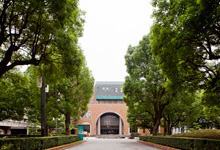Chiba University of Commerce, Yukio Oguri, professor emeritus of the "SoftMobility * CUC Team" organized as part of the president's project, and Chiba Gakuen, an educational foundation, have developed a "moving object speed display warning" that alerts when a car or other vehicle exceeds speed. announced that it has obtained a patent for the device.
Chiba University of Commerce is working on four themes as the president's project to contribute to the SDGs.In theme 4, "Building Safe and Secure Cities and Communities," the "SoftMobility CUC Team" has been conducting research on movement at an appropriate speed that harmonizes pedestrians and moving objects such as cars and bicycles. rice field.
Since 1982, Professor Oguri, who is in charge of the project, has been engaged in research on a "soft car" that incorporates a device that can set and control the maximum speed and can be seen from the outside of the car. Full-scale development began in 2000 with government subsidies, and from 2017, repeated demonstration experiments incorporating new information technology in the president's project, leading to the acquisition of a patent in May 2022.
The patented "moving body speed display warning device" constantly recognizes the speed limit that a moving body should observe, and alerts the driver and other people when the speed is exceeded by flashing the display and audible warning.By installing a commercially available application on a mobile communication terminal such as a smartphone, it becomes possible to measure the speed of a mobile object using GPS, and a mobile speed display warning device is completed.We are considering a unique display device to increase the brightness.The speed limit can be set manually or automatically.
Looking at the world, traffic accidents caused by moving vehicles such as automobiles are extremely common, and according to a WHO report, they are the leading cause of death among people aged 5 to 49 worldwide.As a preventive measure, it is conceivable to incorporate a function into the moving body itself that prevents it from running above a set speed, but it is not easy to incorporate a speed limit mechanism, and the outside will not know that the speed is being controlled. It is expected that the introduction of the "moving body speed display warning device" will promote the slowdown of automobiles through driver awareness and communication with the surroundings.
In the future, it is expected that in the short term, it will be used in parking lots, hospitals, schools, parks, nursing homes, etc., where low-speed driving is required, as well as downtown areas, tourist spots, and private land.In the medium to long term, through experiments in model districts, etc., speed limits will be observed on all roads, speed limits will be reviewed, and policy recommendations will be made for full-fledged consideration and implementation of speed control.
Furthermore, as a device to be used in conjunction with the moving body speed display warning device, we are proceeding with the development of the "accelerator/brake pedal detection display device (ABOiD)" to prevent the mistake of stepping on the accelerator and brake of a car. and established a new company for policy advocacy.The new company and Chiba Gakuen have jointly applied for a patent for ABOiD.

